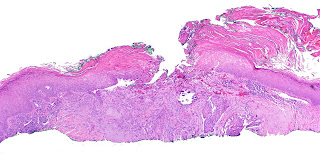The Cold has finally hit us here in the Northeast. People are streaming into dermatology practices with "Winter Itch." This is an article from today's NY Times which should help our computer savvy patients.
Winter Itch
New York Times: Skin Deep Section February 8, 2007
Feeling Parched? Itching Like Crazy? It Must Be Winter
By LAUREL NAVERSEN GERAGHTY

It gets worse as the winter drags on, and weeks of air that is too cold and heat that is too dry take their toll. Arms, thighs, knees, elbows and calves start looking like the surface of the moon: cracked, chalky and stretched. And then comes the itch.
Alexandra Lynner Gilbert, 25, an interior design assistant from Greenwich, Conn., said it has become so bad that she once begged a co-worker to trade sweaters because she needed cotton against her skin.
Allison Schwartz, 33, a graduate student from Brooklyn and self-proclaimed “queen of irrational rashes,” said she now wears only cashmere because any other wool makes her squirm.
Lisa Ziegler, 38, of Fresh Meadows, Queens, said after a hot shower she feels the urge to claw her skin.
And Lisa Henke, 32, of Seattle, said that it took a move from Washington to the drenched air of Washington State to make her skin problems go away.
“Winters in D.C. were horrible for me,” she wrote in an e-mail message. “My skin would become scaly and itchy and would require multiple latherings of lotion to keep from falling off.”
The lower temperatures, humidity-free air and layers of wool and other fabrics can leave skin irritated and uncomfortable.
“A good 25 percent of the population has some degree of winter itch, if not more,” said Dr. Julie Schaffer, an assistant professor of dermatology at New York University School of Medicine. “It’s common to the point where it’s almost a normal thing to have in the winter.”
For most people, it is just an annoyance. But those with conditions that cause itch, like psoriasis or eczema, can really suffer.
“Torturous is a good word for what some people experience,” said Dr. Jeffrey D. Bernhard, who wrote “Itch” (McGraw-Hill, 1994), a textbook.
“People may gouge at their skin, or they may rub and scratch till they bleed,” said Dr. Bernhard, a professor at the University of Massachusetts Medical School in Worcester and editor of the Journal of the American Academy of Dermatology. “Many people would rather put up with pain than itch.”
Dr. Bernhard said it is a lack of moisture that creates the problems. “You have a combination of exceptionally dry, cold air — which indoor heating makes even drier — overbathing and use of harsh soaps,” which can strip the skin of its moisture, he said. “At some point, the dry air will suck water out of your skin like a sponge.”
Without moisture, the skin hardens and flakes and begins to irritate the nerves closest to the surface. “When the outermost skin cells dry out, they have more ragged and sharp edges, and they may be stimulating those fine itch nerve endings in the skin,” Dr. Bernhard said.
In young people there is no difference in skin dryness across ethnicities, said Dr. Victoria Holloway Barbosa, who is the director of L’Oréal Institute for Ethnic Hair and Skin Research. But those who described themselves as African-American or Caucasian in skin studies tend to have increasingly dry skin with age and may be particularly vulnerable to itch later in life, she said. Those who identify themselves as Asian or Latino did not have similar complaints. Doctors said there is no magic cure for itch, but there are simple steps to diminish the problem.
Dr. Michael Tharp, the chairman of the dermatology department at Rush University Medical Center in Chicago, said it should be standard operating procedure “to shower not in hot water, but in lukewarm water.” The hotter the shower water, he said, the more moisture will be extracted from the skin.
He also recommended washing with a mild cleanser, “preferably a moisturizing body wash, which has lots of lipids, which could theoretically put oil into the skin and help repair the barrier functions.”
After stepping out of the shower, it’s good to apply cream or Vaseline within three minutes before the dampness can evaporate, a trick dermatologists call the “soak and smear” technique.
“The only way to rehydrate the stratum corneum” — the skin’s outermost layer — “is to trap it against the skin,” using a thick emollient, said Dr. Tharp, who is a consultant to Unilever, Novartis and other skin care and drug companies.
Dr. Barbosa said a humidifier, bath oil or over-the-counter hydrocortisone cream are other ways to treat dryness and itch.
Certain ingredients can ease the urge to scratch by interfering with the itch signal that travels from the skin to the brain. Creams containing menthol, for example, “actually stimulate the same nerve ending receptors that cold and touch stimulate, so they create another sensation that substitutes for itch,” which would relieve it somewhat, Dr. Bernhard said.
For people who experience nighttime itching that disrupts their sleep, an antihistamine like Benadryl may offer relief, said Dr. Alan R. Shalita, the chairman of dermatology at SUNY Downstate Medical Center, who does consulting, lecturing and research supervision for dermatology and cosmetics companies, including Allergan, Estée Lauder, and Galderma.
“A lot of people notice the itching more at night, because whatever their activities are during the day, it distracts them from feeling the itch,” Dr. Shalita said.
In most cases, the itch should just fade away. But when it persists or becomes more than a minor nuisance, a trip to the doctor becomes worthwhile, Dr. Bernhard said.
“At some point, a diagnosis has to be made, because it could be a sign of an underlying skin disease like eczema or psoriasis or hives, or even a kidney or liver problem,” he said.






